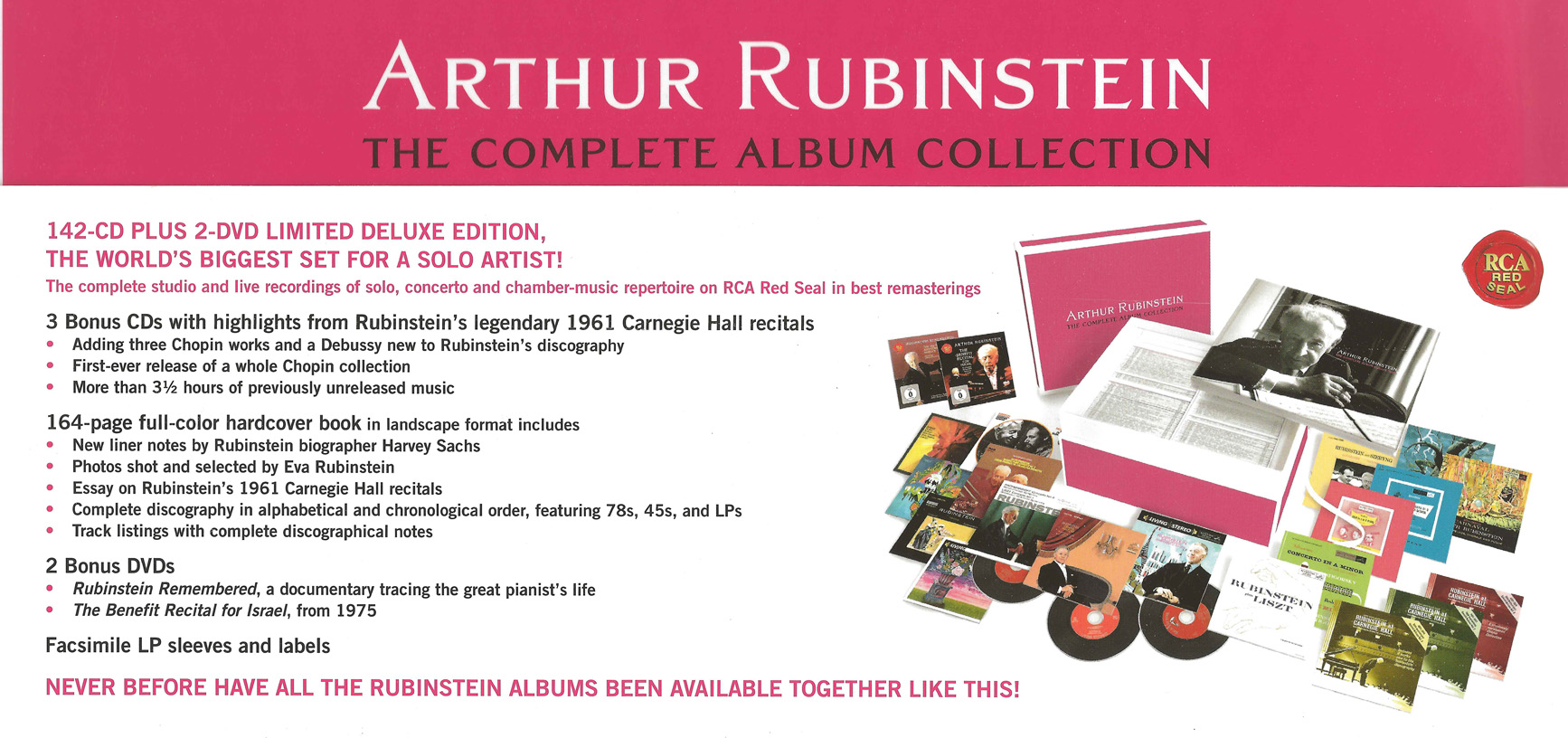Johannes Brahms
Violin Sonata No.2 in A major, op.100
Media Review / Listening Diary 2015-10-17
2015-10-17 — Original posting
2016-08-10 — Brushed up for better readability
Table of Contents
Introduction
In this Listening Diary post, I’d like to discuss three recording of the Violin Sonata No.2 in A major, op.100 by Johannes Brahms (1833 – 1897), a composition that Brahms finished in 1886 in Thun/Switzerland.
The Recordings
I have one recording of this sonata in my LP collection, with Christian Ferras (1933 – 1982) on the violin, and Pierre Barbizet (1922 – 1990) at the piano. That recording is part of a venerable 15-LP box with all of Brahms’ chamber music. I haven’t listened to this recording in decades, and I don’t have plans to recover this recording on CD.
The first CD recording below came with the Arthur Rubinstein Complete Album Collection, the other two are very recent addition to my collection. I’m doing this quick comparison in preparation for an upcoming concert review.
Henryk Szeryng & Arthur Rubinstein (1960)
Arthur Rubinstein — The Complete Album Collection
CD #79: Brahms: Violin Sonatas No.2 in A major, op.100 / No.3 in D minor, op.108
Henryk Szeryng & Arthur Rubinstein
SONY Classical 88691936912 (142 CDs / 2 DVDs, mono / stereo); ℗ / © 2011
Documentation 162 pp., track listing on CD sleeve

Leonidas Kavakos & Yuja Wang (2013)
Brahms: The Violin Sonatas
Decca 478 6442 (CD, stereo); ℗ / © 2014
Booklet: 20 pp. en/fr/de

Isabelle Faust & Alexander Melnikov (2015)
Brahms: Violin Sonatas No.2 in A major, op.100 / No.3 in D minor, op.108
Schumann: 3 Romances op.94; Schumann / Dietrich / Brahms: F.A.E. Sonata
Isabelle Faust & Alexander Melnikov
harmonia mundi HMC 902219 (CD, stereo); ℗ 2015
Booklet: 20 pp. fr/en/de

Johannes Brahms (1833 – 1897): Violin Sonata No.2 in A major, op.100
Johannes Brahms wrote all three of his violin sonatas in the mature period of his life. The sonata op.100 follows almost 10 years after his first sonata in G major, op.78. His third and last sonata, in D minor, op.108, was to follow two years after op.100. Brahms created his sonata No.2 in attendance of the arrival of the young German contralto Hermine Spies, for whom he undeniably felt some affection. Because of its intimate, more introverted nature, the song-like attitude, this work is sometimes called “Lied-like” and referred to as “Thun Sonata”, after the place of its creation. It’s a piece with an inner beauty that may be harder to convey than with Brahms’ other compositions in this genre.
The sonata features three movements:
- Allegro amabile
- Andante tranquillo – Vivace – Andante – Vivace di più – Andante – Vivace
- Allegretto grazioso (quasi Andante)
Comments on the Recordings
I’m posting my comments to the recordings above in chronological order:
Henryk Szeryng & Arthur Rubinstein (1960)
At the time of this recording, Arthur Rubinstein (1887 – 1982) was 73, but technically still in pretty good shape. Henryk Szeryng (1918 – 1988) was at the height of his career. Their recording is a (probably good) conventional interpretation in several ways (apart from the instrumentation, of course): on the violin part, it is dominated by Szeryng’s fairly strong, fast, if not nervous vibrato. Too much for my taste, frankly, but typical for this artist. Then, on both parts, the amount of differentiation, the p playing (and below), the amount of fine and intermediate tones leaves a lot to wish for, in my opinion. Especially when compared to the interpretation by Isabelle Faust & Alexander Melnikov.
Notes on the Movements
I. Allegro amabile
The tempo is more or less OK, at the lower limit of still being Allegro. For the piano introduction see the general remarks above. In the violin, the first, short interjections are OK, with little vibrato. But as soon as the violin is involved in longer phrases / longer tones, Szeryng’s strong & nervous vibrating sets in, which to me defeats all listening pleasure, even makes this hard to listen to. Vibrato should really be an occasional feature / ornament / enhancement, not a permanent / omnipresent feature!
II. Andante tranquillo – Vivace – Andante – Vivace di più – Andante – Vivace
One thing that applies to all movements (apart from the vibrato issue) is that the piano accompaniment is often comparatively solid (especially when compared to Melnikov). This could also be a consequence of the vibrato narrowing down the scope of expression on the violin. This then likely propagates into the accompaniment.
III. Allegretto grazioso (quasi Andante)
Besides the vibrato, Szeryng occasionally uses strong portamento (rather glissando, maybe), which is not adding value (nor emotionality) at all. In these moments it sounds rather old-fashioned. Also, the tempo is on the slow side, the interpretation seems rather heavy (compared to the ones below), lacking the grazioso aspect.
Duration: 8’19” / 6’08” / 5’57” — 20’22” total
Rating: 3.0 (3 / 3 / 3)
Recommendation: Over the years, I have to some degree become allergic against an excess of vibrato and its permanent use; with that, and especially after having listened to Faust / Melnikov, I would state that one can safely disregard this recording, despite the undeniable (general) merits of the two artists.
Leonidas Kavakos & Yuja Wang (2013)
From an instrumentation point-of-view (Yuja Wang plays a modern concert grand), this recent recording can still be seen as conventional. Of course, the 53 years since the recording above have undeniably left their traces in this recording: Leonidas Kavakos (*1967) has a much more natural vibrato that he uses more sparingly than Szeryng. Both Kavakos and Yuja Wang (*1987) are much more differentiated, especially in the dynamics, the articulation is lighter.
Notes on the Movements
I. Allegro amabile
For my taste, Yuja Wang uses a bit too much arpeggiando playing, especially in the introduction. Maybe she was trying to attenuate the strength of the concert grand, to make it sound softer, more lyrical. To me, this is a bit too much here. I don’t dislike arpeggiando playing in general. But like vibrato, it is a feature that should be used with care, and selectively, more like an ornament. Also, the tempo really is a little slow, barely Allegro, rather a fast Andante. Kavakos’ vibrato may sometimes be as strong as Szeryng’s in amplitude. But at least, it is not nervous, and he uses it much more selectively (I would personally still prefer a little less!).
On the bright side, Kavakos sometimes takes back the volume, really into a modest soft & lyrical tone that very much fits the character of the sonata. Yuja Wang is very much “in tune” with the violin, avoids playing herself into the foreground. The dynamic balance is excellent, even though there are clearly limits to how well the violin sound can mix with that of a modern concert grand.
II. Andante tranquillo – Vivace – Andante – Vivace di più – Andante – Vivace
The Andante tranquillo introduction is excellent, very simple and modest in articulation and tone. It avoids any unrest, Kavakos is using almost no vibrato. It’s definitely much better than Szeryng / Rubinstein. In the subsequent parts, the articulation is excellent, very careful. The sound remains transparent and well-balanced. In the Vivace di più, the articulation on the piano could not be better. It’s simply light and transparent, as good as a modern concert grand can do, and the pizzicato on the violin has no problem with making itself heard!
III. Allegretto grazioso (quasi Andante)
The main “fault” here is … that there is a yet better recording, see below! In comparing the two, the modern grand sounds a bit muffled: was the lid closed? The sound is very warm, though, hence the sound may be exactly as intend by the two artists. Kavakos’ vibrato is maybe sometimes at the upper limit? It’s a good, even excellent recording & interpretation, but … see below!
Duration: 8’29” / 6’05” / 5’24” — 19’56” total
Rating: 4.3 (4 / 5 / 4)
Recommendation: An excellent recording, for sure, even very much recommended, especially if you dislike the sound of a period instrument (see below).
Isabelle Faust & Alexander Melnikov (2015)
Among today’s violinists, Isabelle Faust (*1972) is one of my very top favorites. She has come out on top in pretty much all of my comparisons where she was involved. I particularly like her very restricted use of vibrato, her unpretentious playing. She is performing on the Stradivarius violin “Sleeping Beauty” (“Dornröschen”) from 1704. Alexander Melnikov (*1973) is one of her favorite partners in chamber music. In this recording, he plays a Bösendorfer piano from 1875 from his collection. It’s an instrument with wonderful, singing sound characteristics that reminds me of the sound of a fortepiano: a sound that is more transparent (also and especially in the bass register), clearer, lighter, brighter, maybe also more fragile than a modern concert grand. The bass register far less dominant.
In this type of chamber music, particularly in this sonata with its more intimate texture, this instrument has the clear edge over modern ones. It also offers a much richer spectrum of sounds. To me, that’s a clear proof that using period instruments pays off even for works of the late 19th century. Moreover, when paired with Isabelle Faust’s clear, often nearly vibrato-free playing (and the rich, colorful, slightly “grainy” tone of her Strad), this proves to be an ideal instrumental partnership. Both parts are in an effortless discourse. The piano is never in danger of covering the violin. The latter can use the full dynamic scope, down for the finest and softest tones, and its characteristics are in perfect harmony with those of the piano.
Notes on the Movements
I. Allegro amabile
I think that apart from the general advantages of Alexander Melnikov’s instrument for Brahms’ compositions of that period, this Bösendorfer is particularly / ideally suited for the lyrical, flowery tone of this sonata. Compared to this recording, interpretations on a modern concert grand (including the two above) sound coarse, undifferentiated, no matter how well they are played. They cannot match the richness and detail in the soft part of the dynamic scope.
Add to this Melnikov’s detailed, careful articulation, his (and Isabelle Faust’s) thoughtful agogics, dynamics and phrasing, and you have a combination that is hard to match, let alone beat. I also feel that both artists live the lyrical emotionality of this music, speaking directly to the listener’s heart. This may be my subjective opinion, but I think it really pays to listen into this recording, to discover its richness … with the downside that one may not really be able to like or appreciate “conventional” recordings after this!!!
II. Andante tranquillo – Vivace – Andante – Vivace di più – Andante – Vivace
Ah, the clear, singing lines of this melody in the Andante tranquillo and Andante parts! It’s masterful and touching at the same time! Here, Brahms’ annotations molto dolce and sempre più dolce in the accompaniment appear perfectly realized, despite the brighter sound of the instrument (compared to a modern grand piano). The Vivace part is not very fast, but with very light articulation and considerate agogics and dynamics in the accompaniment. In the Vivace di più segment, Isabelle Faust’s pizzicati remain perfectly audible, even when the violin strings are seemingly barely touched — thanks to the transparent sound of the Bösendorfer, and Melnikov’s careful, light articulation.
III. Allegretto grazioso (quasi Andante)
Excellent tempo, and really grazioso: miles away from Szeryng / Rubinstein, really! Note that also Isabelle Faust occasionally uses portamento — but with so much more taste, and only where it makes sense! And again, Melnikov can play out all the busy arpeggi in the expressive, emote sections, also with sustain pedal, without ever being in danger of covering the violin sound. And Isabelle Faust does not need any extra efforts to make her instrument remain audible. Sometimes her bow just barely seems to touch the strings. She merely appears to whisper through her instrument!
Duration: 7’43” / 5’50” / 5’28” — 19’00” total
Rating: 5.0 (5 / 5 / 5)
Recommendation: Sorry about most or all conventional interpretations, but this one has played itself straight into my heart, I cannot deny that I’m really touched by this music and interpretation. Clearly, it’s my absolute, top favorite, making me feel like I have newly discovered this sonata: strongly recommended above all other recordings!
Conclusion
The rating in the three recordings is very (almost oddly) coherent (in my first round I even had 4/4/4 for Kavakos / Wang). This may be taken as indication for the internal coherence of the three interpretations. It is not a sign of laziness / sleazy or negligent judgement on my part: when I did the rating, I was comparing each movement separately, i.e., I compared the first movement in all three recordings, then the second one, etc.
Listening Diary Posts, Overview









